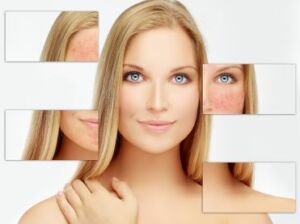Topical treatments offer an ongoing, non-invasive approach to treating facial redness. Prescription-strength medication provides a more effective alternative to over-the-counter treatments. While topical medications vary widely depending on condition, they generally fall into three major categories:
- Antibiotics:Â These drugs help fight bacterial causes of facial redness. They are sometimes combined with low-dose oral antibiotics to help reduce inflammation as well.
- Steroids:Â Steroid creams are used to fight inflammation. The doctor will typically prescribe the lowest effective strength since these drugs can cause side effects.
- Retinoids:Â Retinoid creams contain natural or synthetic vitamin A. They can slow the growth of skin and help unclog pores. They can take several months to work, and they can cause side effects.
Why choose topical treatments for facial redness
Topical treatments offer a non-invasive approach that targets the specific cause of a patient’s facial redness, as diagnosed by a doctor.
Possible risks
- Antibiotics:Â Topical applications can cause skin irritation, redness, dry skin and stinging or burning of the skin. Possible side effects for orally administered antibiotics include stomach discomfort, diarrhea, nausea or vomiting and sore mouth or tongue.
- Steroids:Â Steroid creams can cause side effects such as increased susceptibility to infection, thin skin and stretch marks and enlarged blood vessels. The risk increases with higher doses.
- Retinoids:Â Side effects range from a mild stinging sensation and temporary increase in redness to burning pain and skin peeling. Retinoids also increase the risk of sunburn. Risks associated with isotretinoin include drying of mucous membranes, eyes and skin, nosebleeds, muscle aches, sun sensitivity, poor night vision, increased levels of triglycerides and cholesterol, and birth defects.
What you need to know about topical treatments
- Rosacea:Â Common topical medications include antibiotics such as metronidazole, tretinoin, benzoyl peroxide and azelaic acid. Isotretinoin is a powerful oral medication sometimes used for severe cases of inflammatory rosacea if other treatment options fail to improve symptoms.
- Seborrhea:Â Corticosteroids creams and ointments are the most commonly prescribed topical treatments. In severe cases, they may be used in combination with an oral steroid.
- Acne:Â Typical treatment involves topical retinoids and/or antibiotics. In more severe cases, a doctor may add an oral antibiotic. For the most severe forms of acne, a more powerful topical retinoid, such as isotretinoin, may be prescribed; patients taking these types of drugs must be closely monitored due to their severe side effects.
What to expect after the procedure
Results will vary depending on the condition diagnosed, its severity, topical treatment prescribed and other factors. Patients should talk with their doctor to get a clear understanding of what to expect from their treatment.
How to prepare for the procedure
Before the procedure, an ASDS dermatologist will review the patient’s medical history. This is the time for the doctor and patient to discuss expectations, potential risks and outcomes of the procedure.

